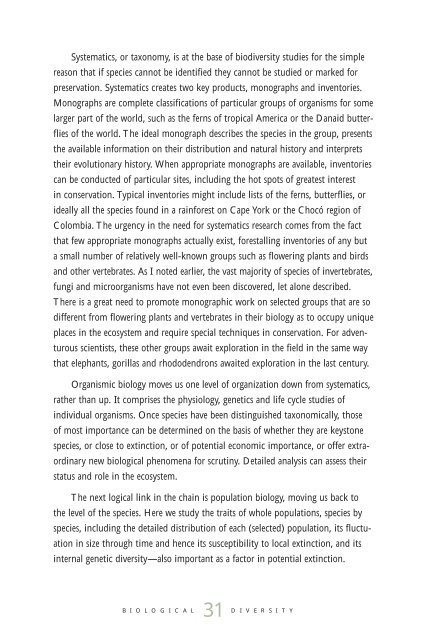Download Biological Diversity - New York State Museum
Download Biological Diversity - New York State Museum
Download Biological Diversity - New York State Museum
You also want an ePaper? Increase the reach of your titles
YUMPU automatically turns print PDFs into web optimized ePapers that Google loves.
Systematics, or taxonomy, is at the base of biodiversity studies for the simple<br />
reason that if species cannot be identified they cannot be studied or marked for<br />
preservation. Systematics creates two key products, monographs and inventories.<br />
Monographs are complete classifications of particular groups of organisms for some<br />
larger part of the world, such as the ferns of tropical America or the Danaid butterflies<br />
of the world. The ideal monograph describes the species in the group, presents<br />
the available information on their distribution and natural history and interprets<br />
their evolutionary history. When appropriate monographs are available, inventories<br />
can be conducted of particular sites, including the hot spots of greatest interest<br />
in conservation. Typical inventories might include lists of the ferns, butterflies, or<br />
ideally all the species found in a rainforest on Cape <strong>York</strong> or the Chocó region of<br />
Colombia. The urgency in the need for systematics research comes from the fact<br />
that few appropriate monographs actually exist, forestalling inventories of any but<br />
a small number of relatively well-known groups such as flowering plants and birds<br />
and other vertebrates. As I noted earlier, the vast majority of species of invertebrates,<br />
fungi and microorganisms have not even been discovered, let alone described.<br />
There is a great need to promote monographic work on selected groups that are so<br />
different from flowering plants and vertebrates in their biology as to occupy unique<br />
places in the ecosystem and require special techniques in conservation. For adventurous<br />
scientists, these other groups await exploration in the field in the same way<br />
that elephants, gorillas and rhododendrons awaited exploration in the last century.<br />
Organismic biology moves us one level of organization down from systematics,<br />
rather than up. It comprises the physiology, genetics and life cycle studies of<br />
individual organisms. Once species have been distinguished taxonomically, those<br />
of most importance can be determined on the basis of whether they are keystone<br />
species, or close to extinction, or of potential economic importance, or offer extraordinary<br />
new biological phenomena for scrutiny. Detailed analysis can assess their<br />
status and role in the ecosystem.<br />
The next logical link in the chain is population biology, moving us back to<br />
the level of the species. Here we study the traits of whole populations, species by<br />
species, including the detailed distribution of each (selected) population, its fluctuation<br />
in size through time and hence its susceptibility to local extinction, and its<br />
internal genetic diversity—also important as a factor in potential extinction.<br />
B i o l o g i c a l<br />
31 D i v e r s i t y
















